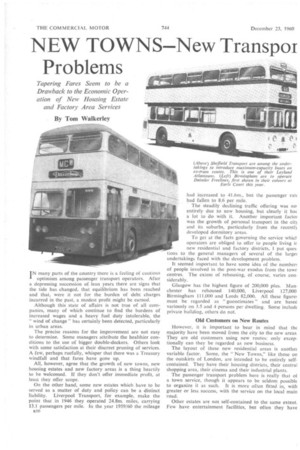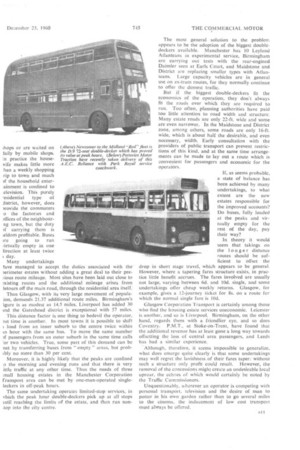NEW TOWNS—New Transpoi Problems
Page 44

Page 45

If you've noticed an error in this article please click here to report it so we can fix it.
Tapering Fares Seem to be a Drawback to the Economic Operation of New Housing Estate and Factory Area Services
By Tom Walkerley
I N many parts of the country there is a feeling or cautious optimism among passenger transport operators. After a depressing succession of lean years there are signs that the tide has changed, that equilibrium has been reached and that, were it not for the burden of debt charges incurred in the past, a modest profit might be earned.
Although this state of affairs is not true of all companies, many of which continue to find the burdens of increased wages and a heavy fuel duty intolerable, the "wind of change" has certainly been detected, particularly in urban areas.
The precise reasons for the improvement are not easy to determine. Some managers attribute the healthier conditions to the use of bigger double-deckers. Others look with some satisfaction at their discreet pruning of services. A few, perhaps ruefully, whisper that there was a Treasury windfall and that fares have gone up.
All, however, agree that the growth of new towns, new housing estates and new factory areas is a thing heartily to be welcomed. If they don't offer immediate profit, at least they offer scope.
On the other hand, some new estates which have to be served as a matter of duty and policy can be a distinct liability. Liverpool Transport, for example, make the point that in 1946 they operated 24.8m, miles, carrying 13.1 passengers per mile. In the year 1959/60 the mileage a10 had increased to 41.6m., but the passenger rati had fallen to 8.6 per mile.
The steadily declining traffic offering was no entirely due to new housing, but clearly it has a lot to do with it. Another important facto' was the growth of personal transport in the cit5 and its suburbs, particularly from the recent13 developed dormitory areas.
To get at the facts governing the service whicloperators are obliged to offer to people living ir new residential and factory districts, I put questions to the general managers of several of the large] undertakings faced with the development problem.
It seemed important to have some idea of the number: of people involved in the post-war exodus from the towr centres. The extent of rehousing, of course, varies considerably.
Glasgow has the highest figure of 200,000 plus. Manchester has rehoused 140,000, Liverpool 127,000 Birmingham 111,000 and Leeds 82,000. All these figure: must be regarded as "guesstimates" and are based variously on 15 and 4 persons per dwelling. Some include private building, others do not.
Old Customers on New Routes
However, it is important to bear in mind that the majority have been moved from the city to the new areas They are old customers using new routes: only excep. tionally can they be regarded as new business.
The layout of these new residential areas is anothel variable factor. Some, the "New Towns," like those or the outskirts of London, are intended to be entirely selfcontained. They have their housing districts, their central shopping area, their cinema and their industrial plants.
The passenger transport problem here is really that ol a town service, though it appears to be seldom possible to organize it as such. It is more often fitted in, with greater or less success, with the service on the local main road.
Other estates are not self-contained to the same extent. Few have entertainment facilities, but often they have
;hops or are waited on 'ally by mobile shops. Lo practice the housevife makes little more Ilan a weekly shopping rip to town and much A the household enterainrnent is confined to elevision. This purely -esidential type of district, however, does )rovide the commuters
o the factories and )ffices of the neighbourng town, but the duty )f carrying them is ,eldom profitable. Buses ire going to run rirtually empty in one lirection at least twice day.
Many undertakings tave managed to accept the duties associated with the )erimeter estates without adding a great deal to their pre/ions route mileage. Most sites have been laid out close to misting routes and the additional mileage arises from letours off the main road, through the residential area itself.
Thus Glasgow, with its very large movement of populaion, demands 21.37 additional route miles. Birmingham's igure is as modest as 14.5 miles, Liverpool has added 30 tnd the Gateshead district is exceptional with 57 miles.
This distance factor is one thing to bedevil the operator, )ut time is another. In most towns it is possible to shift t load from an inner suburb to the centre twice within in hour with the same bus. To move the same number A passengers from an outer suburb in the same time calls or two vehicles. True, some part of this demand can be net by transferring buses from empty" areas, but probibly no more than 30 per cent.
Moreover, it is highly likely that the peaks are confined o the morning and evening runs and that there is very ittle traffic at any other time. Thus the needs of three .mall housing estates in the Manchester Corporation Transport area can be met by one-man-operated singleleckers in off-peak hours.
The same undertaking operates limited-stop services, in vhich the peak hour double-deckers pick up at all stops intil reaching the limits of the estate, and then run nontop into the city centre. The most general solution to the problem appears to be the adoption of the biggest doubledeckers available. Manchester has 10 Leyland Atianteans in experimental service, Birmingham are carrying out tests with the rear-engined Daimler seen at Earls Court, and Maidstone and District are replacing smaller types with Allanteans. Large capacity vehicles are in general use on ex-tram routes, for they normally continue to offer the densest traffic.
But if the biggest double-deckers fit the economics of the operation, they don't always fit the roads over which they are required to run. Too often, planning authorities have paid too little attention to road width and structure. Many estate roads are only 22-ft. wide and some are even narrower. In the Maidstone and District zone, among others, some roads are only I6-ft. wide, which is about half the desirable, and even necessary, width. Early consultation with the providers of public transport can prevent restrictions of this kind, and at the same time arrangements can be made to lay out a route which is convenient for passengers and economic for the operators.
If, as seems probable, a state of balance has been achieved by many undertakings, to what extent are the new estates responsible for the improved accounts? Do buses, fully loaded at the peaks and virtually empty for the rest of the day, pay their way?
In theory it would seem that takings on the longer distance routes should be sufficient to offset the drop in short stage travel, which appears to be general. However, where a tapering fares structure exists, in prac, lice little benefit accrues. The fares involved are usually not large, varying between 6d. and 10d. single, and some undertakings offer cheap weekly returns. Glasgow, for example, gives a 12-journey ticket for 8s, on a route for which the normal single fare is 10d.
Glasgow Corporation Transport is certainly among those who find the housing estate services uneconomic. Leicester is another, and so is Liverpool. Birmingham, on the other hand, regards them with a friendlier eye, and so does Coventry. P.M,T., at Stoke-On-Trent, have found that the additional revenue has at least gone a long way towards offsetting the loss of central area passengers, and Leeds has had a similar experience.
Although, therefore, it seems impossible to generalize, what does emerge quite clearly is that some undertakings may well regret the lavishness of their fares taper: without such a structure only profit could result. However, the removal of the concessions might create an undesirable local uproar, the echces of which would certainly be noted by the Traffic Commissioners.
Unquestionably, wherever an operator is competing with personal transport, television and the desire of man to potter in his own garden rather than to go several miles to the cinema, the inducement of low cost transport must always be offered.




























































































